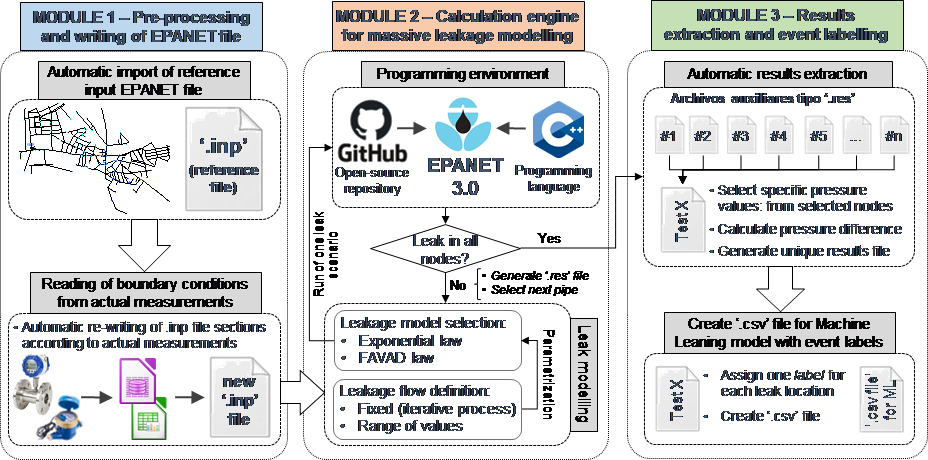Research
The main lines of research of the group are briefly described classifying them into those related to Machine Learning (ML) techniques and numerical methods. Related on-going or recently finished projects are indicated.
Research activities involving Machine Learning techniques
- Machine learning for dam safety assessment (PIs: Fernando Salazar)
- Development of methodologies and software for analysis of dam monitoring data, including generation of ML predictive models and their interpretation, with the final objective of supporting decision making in dam safety. Related to: product PREDATOR/SOLDIER
 Figure 1. Software for dam safety assessment through ML: screenshots of PREDATOR/SOLDIER application
Figure 1. Software for dam safety assessment through ML: screenshots of PREDATOR/SOLDIER application
- New computational tools for reliability-based dam safety assessment (PIs: Fernando Salazar and Joaquin Irazábal)
- Use of ML models to support FEM analysis to predict dam response including uncertainty and risk analysis. Related to: project TRISTAN
 Figure 2. Anomaly detection in dams: example of monitoring network (left) and numerical model to simulate anomalous events (right).
Figure 2. Anomaly detection in dams: example of monitoring network (left) and numerical model to simulate anomalous events (right).
- Leakage management in Water Distribution Networks (WDN) (PI: David J. Vicente)
- Development of data-driven classification models based on pressure monitoring data, combining ML techniques and graph theory for leakage detection and location. Related to: project SMILER.
 Figure 3. Leakage location in WDN through ML: pressure sensors location (left), probability analysis through classification ML model (center) and map visualization of leak location results.
Figure 3. Leakage location in WDN through ML: pressure sensors location (left), probability analysis through classification ML model (center) and map visualization of leak location results.
- Analysis of hydraulic structures
- Analysis of the hydraulic performance of dam spillways and bottom outlets combining numerical methods (PFEM, Free-Surface) and ML techniques.
 Figure 4. Spillway hydraulic performance: example of geometry (left) and relationship between observed and predicted values from ML models of discharge capacity
Figure 4. Spillway hydraulic performance: example of geometry (left) and relationship between observed and predicted values from ML models of discharge capacity
- Smart optimization of industrial processes (PI: Fernando Rastellini)
- Support and optimization of rotational metal deformation design processes. Use of FEM-based Digital Twin framework combined with ML classification techniques. Related to: project OPTIPRO
 Figure 5. Metal-forming processes analysis: industrial equipment (left) and GUI for process parametrization (right)
Figure 5. Metal-forming processes analysis: industrial equipment (left) and GUI for process parametrization (right)
- Water quality and water treatment techniques
- Application of ML models for the prediction of water quality status in water bodies and assessment of advanced water pollutant removal treatments. Related to: ‘AULA ETSI.UPM-CIMNE’ master's thesis; European proposal DIRECT (Green Deal call – under evaluation).
 Figure 6. Aquifer quality analysis: Duero river basin monitoring network (left) and feature importance analysis through ML techniques (centre and right)
Figure 6. Aquifer quality analysis: Duero river basin monitoring network (left) and feature importance analysis through ML techniques (centre and right)
- Development of calibration utilities (PIs: Fernando Salazar and Joaquin Irazábal)
 Figure 7. Calibration of DEM parameters of clay behavior: numerical model to simulate clay behavior tests (left), and calibration analysis through ML (center and right)
Figure 7. Calibration of DEM parameters of clay behavior: numerical model to simulate clay behavior tests (left), and calibration analysis through ML (center and right)
Research activities involving numerical methods
- Thermo-mechanical behavior of concrete dams.
- Simulation of concrete dam behavior during construction and operation stages integrating high-detailed thermo-mechanical loads. Related to: project ACOMBO; Software application ‘Dam Application’ (integrated in Kratos framework).
 Figure 8. Concrete dam modelling: construction stage simulation (left), displacements field (center) and stresses field (right)
Figure 8. Concrete dam modelling: construction stage simulation (left), displacements field (center) and stresses field (right)
- Design of wedge shaped block spillways (PI: Fernando Salazar)
- CFD simulation through Eulerian FEM modelling and block stability simulation through DEM modelling. Related to: project PABLO.
 Figure 9. Wedge shaped block spillways simulation: hydraulic analysis (left), block design (center) and block stability analysis (right)
Figure 9. Wedge shaped block spillways simulation: hydraulic analysis (left), block design (center) and block stability analysis (right)
- Industrial design of dam fuse gates (PI: Fernando Salazar)
- Fluid-solid interaction simulations through PFEM+DEM modelling to calculate the following processes: discharge flow for different gate positions, gate falling velocity and gate-wall impact force. Related to: project COFRE.
 Figure 10. Fuse gates simulation: geometry design (left), fluid-solid interaction 2D simulation (center) and 3D simulation (right)
Figure 10. Fuse gates simulation: geometry design (left), fluid-solid interaction 2D simulation (center) and 3D simulation (right)
- CFD analysis of hydraulic structures: highly convergent spillways, stilling basin and drainage systems modelling
- Simulation of complex 3D hydraulic phenomena, through FEM and PFEM models, such as free surface position of hydraulic jump, pressure and velocity fields and identification of zones with erosion risk. Related to: project ‘Sant Ponç dam’, project ‘Drainage of the new Bernabeu stadium’
 Figure 11. CFD analysis of hydraulic structures: highly convergent spillways (left) and stilling basin simulation (right)
Figure 11. CFD analysis of hydraulic structures: highly convergent spillways (left) and stilling basin simulation (right)
- Smart optimization of industrial processes
- Simulation of railway infrastructures against climate change actions and evaluation of railway ballast response through DEM model. Related to: project RESILTRACK.
 Figure 12. Railway infrastructure simulation: ballast behavior simulation (left), calibration analysis (center) and railway infrastructure simulation (right)
Figure 12. Railway infrastructure simulation: ballast behavior simulation (left), calibration analysis (center) and railway infrastructure simulation (right)
- Numerical modelling of WDN (PI: David J. Vicente)
- Development of numerical models for leakage simulation through advanced pressure-driven solvers. Related to project SMILER.
 Figure 13. Methodological scheme of advanced numerical utility to simulate massive cases of leakage scenarios in WDNs
Figure 13. Methodological scheme of advanced numerical utility to simulate massive cases of leakage scenarios in WDNs
